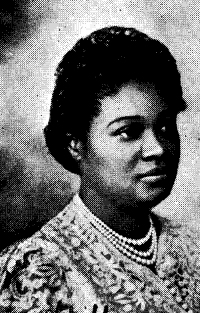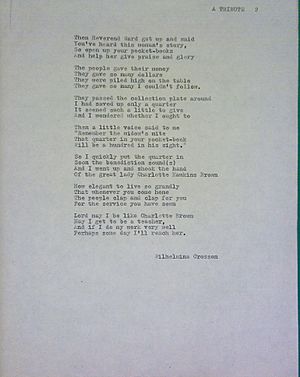Wilhelmina Marguerita Crosson facts for kids
Quick facts for kids
Wilhelmina M. Crosson
|
|
|---|---|
 |
|
| Born | April 26, 1900 Rutherford, New Jersey, U.S.
|
| Died | May 28, 1991 Boston, U.S.
|
| Occupation | Educator |
| Known for | Pedagogy |
Wilhelmina Marguerita Crosson (born April 26, 1900 – died May 28, 1991) was a special teacher and school leader. She was known for her new and creative ways of teaching. She was one of the first African-American women to teach in Boston.
In 1935, she created Boston's first program to help students who struggled with reading. She also believed it was very important to teach about black history early on.
Contents
Early Life and Learning
Wilhelmina Marguerita Crosson was born in Rutherford, New Jersey. Her birthday was April 26, 1900. Her parents were Charles Tasker Crosson and Sallie Alice Davis Crosson. She was the fourth of nine children in her family.
In 1906, her family moved to Boston. There, she went to the Hyde School and Girls' High School in Roxbury. She earned her first college degree in education in 1934 from Boston Teachers College. Later, in 1954, she earned a master's degree from Boston University. This degree was in how to run schools.
A Career in Education
Crosson started her teaching career in 1920. She taught at the Hyde School in Boston's North End. She helped children of Italian immigrants learn to read better. She was one of the first African-American women to teach in Boston's public schools.
She was also one of the first teachers in America to see that some students needed extra help with reading. In 1935, she started Boston's first special reading program. Her new teaching methods worked so well that other teachers and school leaders often came to watch her classes. She was also asked to give talks about her ideas.
In 1925, she started the Aristo Club of Boston. This was a group of black professional women. They studied and taught black history. They also gave scholarships to black children to help them go to school. Because of the Aristo Club's hard work, the Boston school system began celebrating Negro History Week.
Writing About Black Culture
In 1933, Crosson wrote an important article. It was called "The Negro in Children's Literature." This article was published in a teaching magazine called Elementary English Review. It was the first time a major American teaching magazine asked teachers to celebrate African-American culture. It was also the first article by a black author in that magazine.
In her article, Crosson suggested teaching "Negro literature." This meant books by, for, and about black people. She believed black children should learn about their own culture. She also thought all children would learn from this experience. She wrote that it was important for American students to learn about the black race. She said they came to America over 300 years ago and became a key part of the nation.
She also suggested teaching African-American history. She thought teachers should show the achievements of African Americans like Harriet Tubman. These achievements should be taught alongside those of white people. She believed this would help black children want to achieve great things. It would also help white children understand that black people helped build America.
Later Teaching and Leadership
In 1945, Crosson took time off from teaching. She went to Mexico to study how public schools taught about different cultures. She did this for the Association for the Study of African American Life and History. She was one of the few women given such a task by this group back then. She was later chosen to be on their main council.
When she came back, she taught at the all-black Hyde School in Roxbury. She made many changes to what was taught there. She also helped her students love reading. On Saturdays, she volunteered to teach black history lessons. She also taught Sunday school at the Twelfth Baptist Church.
In 1952, Crosson became the president of the Palmer Memorial Institute. This was a special school for black students in Sedalia, North Carolina. She started many new programs at the school. She also got money from the government and the Ford Foundation. She retired from her work in 1966.
In 1968, she worked with North Carolina College. She helped create a training program for Peace Corps volunteers. These volunteers were going to work in Liberia. In 1970, she moved back to Boston. There, she volunteered at homeless shelters and helped tutor students. She passed away at her home in the South End of Boston when she was 91 years old.
Awards and Recognition
Wilhelmina Crosson received many honors for her important work:
- She was honored by the Florida Association of Colored Women in 1960.
- She received the Mrs. W. V. S. Tubman award in 1964.
- She won the Sojourner Truth award in 1969. This was from the Boston and Vicinity Negro Business and Professional Women's Clubs.
- She received the Dolly Madison award in 1971 from the Greensboro, North Carolina Chamber of Commerce.
- She won the Boston Afro-American Griot Award from Boston College in 1985.
- She was honored by Action for Boston Community Development in 1985.
- In 1991, the Wilhelmina M. Crosson Scholarship fund was created at the Twelfth Baptist Church in Boston.
- Her name is also mentioned on the Boston Women's Heritage Trail. This is because of her connection to the League of Women for Community Service.


